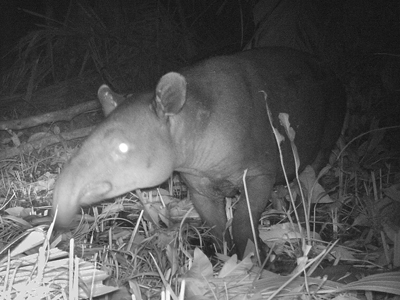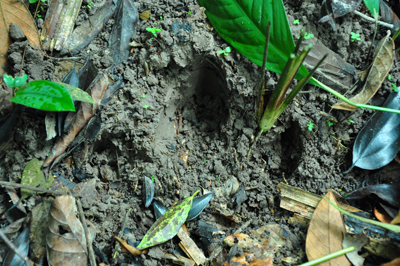

| Welcome |
| A Neotropical Rainforest |
| Nicaragua |
| Rainforest Research |
Plants: |
| Insects: |
| Bullet Ants |
| Leafcutter Ants |
| Birds: |
| Mammals: |
| Howler Monkeys |
| Three-toed Sloth |
| Baird's Tapir |
| Jaguar |
| White-lipped Peccary |
| Agouti |
| Reptiles and Amphibians: |
| Red-eyed Tree Frog |
| Poison Dart Frog |
| Helmeted Iguana |
| Eyelash Viper |
| Terciopelo Viper |
| Spectacled Caiman |
| American Crocodile |
| Human Systems: |
| Rainforest Boy |
| Rainforest Girl |
| Traditional Ecological Knowledge |
| Deforestation |
| Rainforest Research |
|
Baird's Tapir
The local names for the Tapir are "Mountain Cow" and Danto. Mountain cows are herbivores, so as they move about they only eat foods from plants like leaves, small branches, and fruits. Sometimes when they eat the fruits of palms and trees they swallow the whole seed. Then as they travel around the forest and the swamp they help to reforest the area by dropping these seeds in their droppings. Mountain cows usually only have a single young-one per year. The baby is speckled and stays with its mother for one to two years before heading off on its own. There is a lot that scientists do not know about mountain cows because they are scarce and very shy, especially in areas where people hunt them for food.
Research on Baird's Tapir in Nicaragua
Our research has shown with photos like the one above and through finding Tapir tracks in the mud that the Baird's Tapir is NOT EXTINCT on the Atlantic Coast of Nicaragua. Our findings will better inform the scientists and managers who are trying to conserve Baird's Tapirs. Our work is showing the opposite of what people thought was true. Instead of being extinct, there is a small but thriving population of Baird's Tapirs in our region.
|

Copyright Gerald R. Urquhart
Michigan State University
Students and teachers have permission to quote text and use images from this website in class assignments. Images may be used in classroom and academic presentations with notification of author. All other use should request permission.
Virtual Rainforest development supported by grant #0815966 from the




